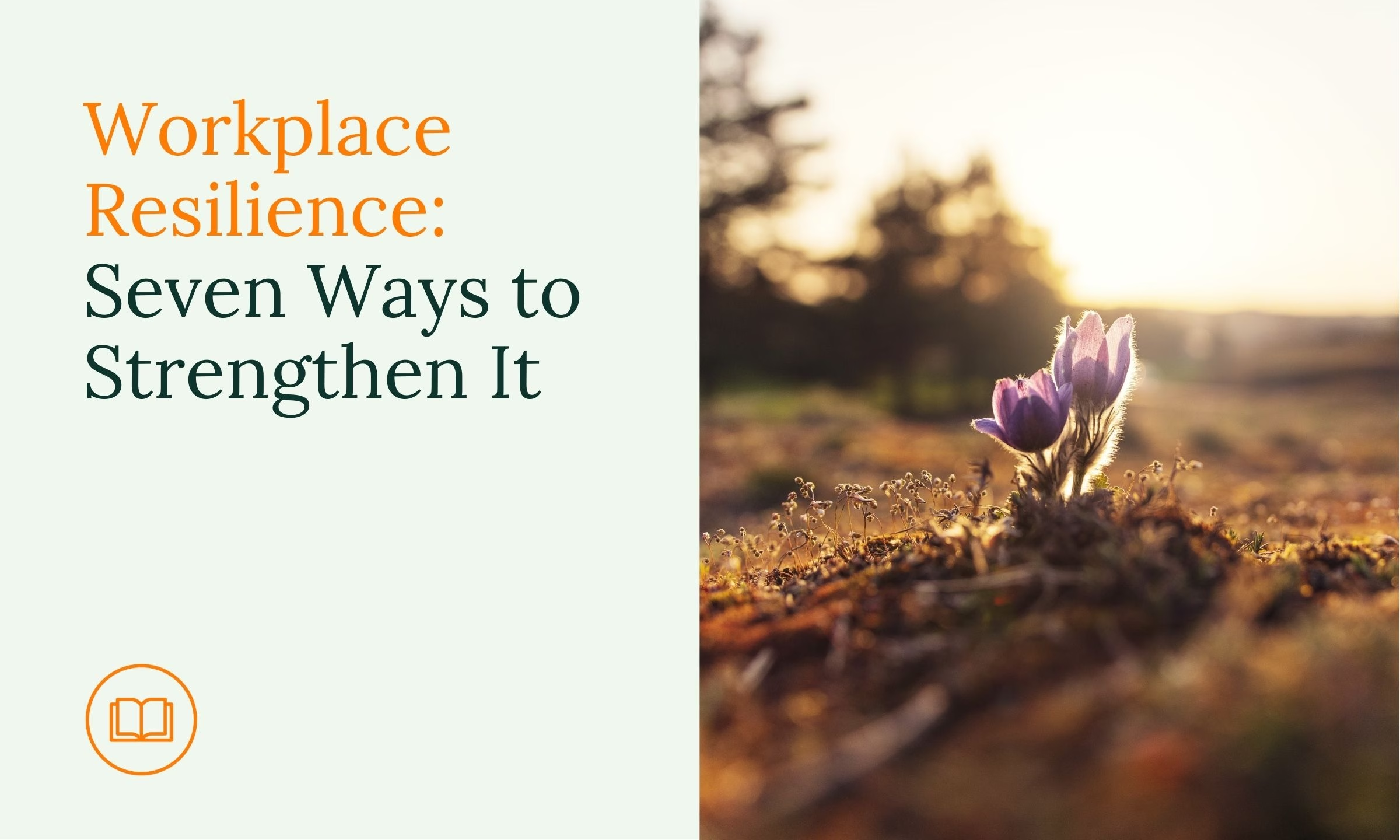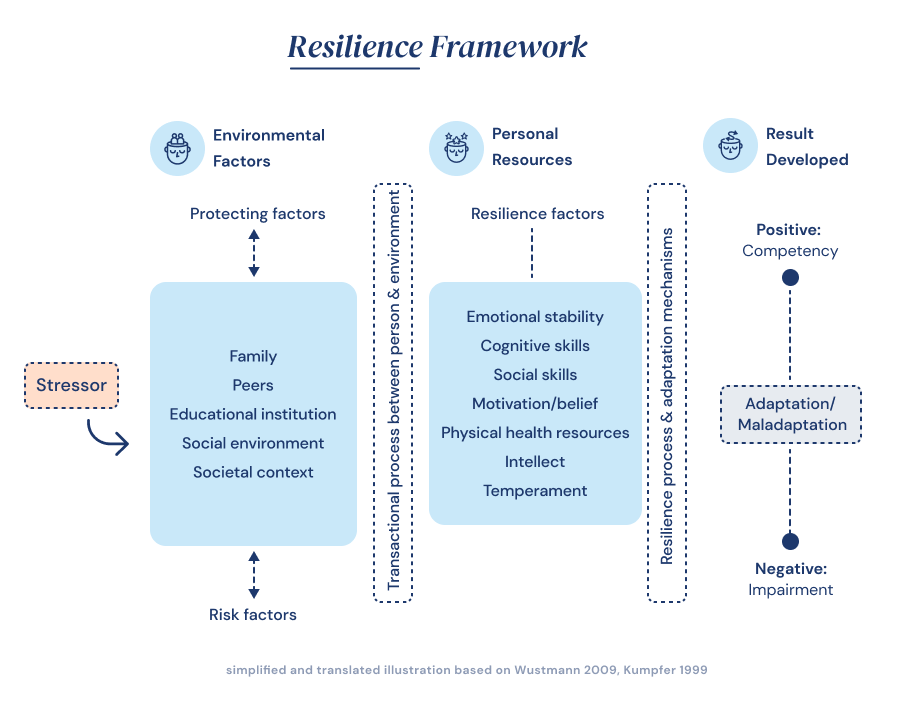Resilient people have the ability to overcome crises, setbacks or losses and spring back to normal life more effectively. Many companies believe workplace resilience is one of the leading metrics for business success because a resilient team can pivot quickly and approach challenges positively. But why are some people more resilient than others? What exactly does it mean to be resilient? And how can leaders and HR help build a resilient team?

Resilience – Mental Strength You Can Train Like a Muscle
Many of us have already experienced crises that have thrown us off course. For some of us, this can be the beginning of a big downward spiral. Others might find it easier to pick themselves up, dust themselves off, and start pursuing answers to their issues. Psychology calls them “resilient”. But what does that mean? What makes a person resilient? Is resilience innate? Or can it be learned? Read on for answers to those questions and more.
What does resilience mean?
The term “resilience” is derived from the Latin word “resilire,” which means “to bounce back”. The first science to use the term was physics. It used “resilience” to describe the ability of a material to bounce back to its original shape even after extreme external impacts.
In the 1970s, the meaning of the term was first applied to people in psychology. It was at this time that the first researchers began to look at the subject and try to answer its fundamental questions: What is resilience? How can it be measured? What makes it tick?
Today, the dictionary describes “resilience” as “psychological resistance; the ability to survive difficult life situations without lasting impairment”.
In addition, there are countless other definitions for the term “resilience”, from which a variety of resilience models are derived. They all attempt to explain why resilient people recover more quickly than others after life crises, traumatic experiences, and other stresses.
Resilience in the Workplace
From an HR perspective, a resilient workforce translates into a more productive and happier team. When employees are equipped to manage stress and workplace challenges effectively, they navigate obstacles with confidence and composure, reducing burnout and inefficiencies.
Moreover, workplace resilience promotes a culture of well-being. Team members experience improved mental health and greater satisfaction in their roles, which leads to higher engagement, better collaboration, and a stronger sense of purpose. Investing in resilience isn’t just a benefit to individuals; it’s a strategic move that drives business success by enhancing morale and overall workplace harmony.
A resilient workforce can help your company’s overall success by offering:
- Improved Stress Management: Resilient employees are better equipped to handle high-pressure situations, ensuring that stress doesn’t hinder productivity or lead to burnout.
- Enhanced Adaptability: Teams with resilience adapt quickly to changes, whether it’s new projects, organizational shifts, or unexpected challenges, minimizing downtime and disruption.
- Increased Job Satisfaction: A resilient workforce feels more confident and supported, leading to higher job satisfaction and retention rates.
- Stronger Team Collaboration: Workplace resilience fosters better communication and conflict resolution, enabling teams to work together more effectively even during challenging times.
- Higher Engagement and Innovation: Resilient employees are more likely to stay engaged and bring creative solutions to problems, contributing to a culture of continuous improvement and success.
Why are some people more resilient than others?
Researchers have been working on this question for decades and in general agree that a person’s resilience depends on several factors. How these respective factors interact is crucial.
One explanation of how resilience develops is provided by what is known as the “resilience framework model.” It traces the path from the stressors, i.e. the crisis, through environmental factors and personal resources to the person’s accomplished adaptation:

In the figure, we already find a few of the factors that can play a role in this adaptation process. Our environment provides external factors, and internal factors come from each person’s individual personality and characteristics. These external and internal factors can either strengthen our resilience, in which case we call them protective factors. But if the factors weaken our resilience, we call them risk factors.
Let’s take a closer look at some of those factors.
External factors from your environment might include protective factors like:
- A secure circle of friends
- Family support
- Team cohesion at work
External factors from your environment could also include risk factors like:
- Poverty
- Lack of social ties
- Work pressure and overtime
Internal factors from your personality might include protective factors like:
- High self-esteem
- A goal-oriented outlook
- Acceptance and tolerance
Internal factors from your personality could also include risk factors like:
- Perfectionism
- Fear of making mistakes
- Self-criticism
The Seven Pillars of Workplace Resilience For Teams and Leaders
Different resilience models have their own factors to make people more resilient. One popular and standard models comes from Ursula Nuber, a German psychologist and former editor-in-chief of the magazine Psychologie Heute. She defined the “seven pillars of resilience” as the following:
1. Optimism
People who are resilient are basically optimistic about life. Even difficult times eventually come to an end and there are always things you can do to improve your situation.
2. Acceptance
Resilient people accept that they cannot (yet) change some things. They also accept their own weaknesses, mistakes, and limitations.
3. Ability to Act
Resilient people do not see themselves as victims but actively shape their lives. This does not mean they never feel helpless, but they always take the opportunity to act when they can.
4. Taking Responsibility
Resilient people have a good sense of what they can and cannot influence. They do not take responsibility for events outside their scope of action, but they also don’t shy away from circumstances they can change.
5. Goal-Oriented
Resilient people don’t focus on problems — they focus on solutions.
6. Networking
Our relationships with others are important for our health. Resilient people actively cultivate their network, share their problems and ask for support.
7. Future Planning
The future can feel volatile, for all of us. But resilient people plan and set goals, and have more positive emotions and confidence as a result.
Other models also include factors such as self-efficacy, realism, creativity, self-care, willingness to learn, improvisational skills, empathy, or impulse control. However, these seven pillars are found in one form or another in almost all models. They are therefore often considered the basis in resilience research.
Benefits of Resilience: Why It Pays to Be Resilient
Resilience is considered one of the keys to success, especially in a professional context. After all, it helps us deal with challenges more calmly. Three advantages stand out in particular:
1. You can handle change well
Many claim that in today’s working world, the only constant is change. As a person who is not easily unsettled by change, you have a clear advantage.
2. In stressful situations, you lend a hand
Resilient people are usually spared headlong panic. They don’t panic about a mountain fo work, but instead start working on solutions to turn that mountain back into a molehill.
3. After work, you relax more easily
Switching off is a challenge for many in this day and age. Resilient people, however, manage to switch off even in stressful times in order to recover and recharge.
All this helps protect your psyche and prevent exhaustion and even burnout. Resilience can therefore help you to find a work-life balance, to make and maintain friendships more easily, and to go through life more openly.
How to Strengthen Resilience – Seven Practical Tips for More Mental Strength
After 50 years of resilience research, there are a number of recommendations to help us become more resilient. They all aim to promote all those protective factors that we can influence ourselves. Below are a few tips you can try.
1. Look for new challenges
Expand your horizons by learning something new. For example, a new language can open up a whole new culture to you, and the small successes along the way will strengthen your belief in yourself. This in turn makes you more resilient when things don’t go so well.
2. Turn to the people in your life who are good for you
A good friend, family member, or a particular sympathetic teacher: any relationship with someone who makes you feel good is worth nurturing. In addition, don’t hesitate to let others help you when you need it.
3. Focus on the solution, not the problem
Rather than mentally dissecting a problem into all its parts and looking for culprits, think about how you can solve a problem. Make the possible solution a goal you can work toward.
4. Stay confident even when things go wrong
Sometimes things don’t work out the way we imagine. Only when we learn to accept defeats as part of life and as an opportunity to learn, can they become new opportunities.
5. Keep a diary
Putting thoughts on paper helps a lot of people to let go. When we write down what’s on our mind, we often understand what’s actually going on inside us and can better deal with thoughts and feelings. Studies have shown that this is good for our general mood.
6. Be aware of what you have already achieved
Everyone has been through crises: a failed exam at school, a relationship breakdown, the loss of a loved one. If you look back from time to time and remind yourself of what you’ve overcome, you can increase your self-confidence and be more confident that you’ll overcome future crises.
7. Invest time in planning and prioritizing
Especially in stressful times, we tend to work frantically to get as much done as quickly as possible. However, if you take the time to plan your day well and prioritize your tasks, you can get the really important things done even in hectic phases. In this way, we allow ourselves the feeling of having accomplished something, despite the long list. This motivates and reassures at the same time.
How Leaders and HR Can Build a Resilient Workforce
Individual resilience is very important. But as a HR leader, you have the unique opportunity not only to build your own resilience, but to increase the resilience of everyone on your team and watch your company perform as a result. Here are some tactics to get you started:
1. Communicate Openly and Honestly
Clear communication helps everyone feel like they’re on the same page. If you make sure that your team knows how the company is going, they’re less likely to be blindsided by challenges or sudden changes. Encourage a culture of transparency where employees feel safe sharing their concerns or struggles. Regular one-on-one check-ins, feedback sessions, and an open-door policy can help identify stress points before they become overwhelming.
2. Facilitate Skill-Building Opportunities
Resilience grows when employees feel competent and prepared. Offer training programs that build problem-solving skills, adaptability, and confidence in managing change. Encourage continuous learning through courses, seminars, or mentorship programs.
3. Foster Team Cohesion
Strong interpersonal relationships at work are key to resilience. Organize team-building activities, social events, or collaborative projects to strengthen bonds between team members. A supportive team can act as a safety net during challenging times.
4. Encourage Work-Life Harmony
Ensure employees have the time and space to recharge. Promote flexible working arrangements, set realistic workloads, and encourage taking regular breaks. By preventing burnout, you create an environment where resilience can thrive.
5. Offer Mental Health Support
Provide access to mental health resources such as counseling services or stress management workshops. Acknowledging the importance of mental health sends a clear message that employees’ well-being is a priority.
Not sure where to get started? nilo boosts resilience and makes it easy for your team to perform at their best, every day. Book a free demo now.








